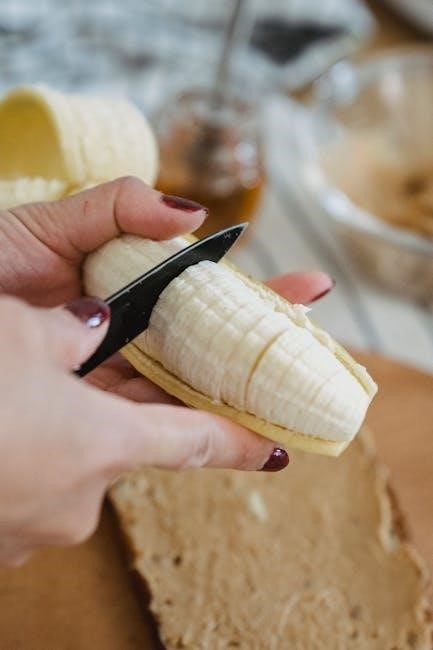Bread Slicer Manual: A Comprehensive Guide
This guide provides detailed instructions for operating and maintaining your bread slicer. It covers everything from pre-use checks and slicing techniques to cleaning, safety, and troubleshooting. Specific model instructions are included, ensuring optimal performance.
Bread slicers are essential tools for achieving consistent and uniform slices of bread. They are available in various forms, from manual to electric, catering to diverse needs. Whether you’re a home baker or running a commercial bakery, a bread slicer can significantly improve efficiency and presentation. This manual will guide you through the features, operation, and maintenance of different bread slicer types. Understanding the proper use and care of your bread slicer will ensure its longevity and consistent performance. From adjusting slice thickness to mastering safety precautions, this guide provides comprehensive information for optimal use.
Types of Bread Slicers
Bread slicers come in two primary types: manual and electric. Each type offers distinct advantages depending on the intended use, volume of slicing, and desired level of automation.
Manual Bread Slicers
Manual bread slicers offer a traditional approach to slicing bread, providing more control over the process. These slicers often feature a hand crank and adjustable thickness settings, allowing users to customize slices to their preference. Zassenhaus bread slicers are a prime example, known for their classic design and ease of use. These slicers are perfect for homemade bread and smaller bakeries. They are generally foldable for easy storage and don’t require electricity, making them a versatile option. Manual operation requires more physical effort but ensures a more artisanal touch.
Electric Bread Slicers
Electric bread slicers offer a convenient and efficient solution for slicing bread, especially in commercial settings. These slicers use a motor to power a blade, allowing for faster and more consistent slices. Models like the Oliver bread slicer are known for their sturdy design and ability to handle various bread types. Electric slicers often include safety features like blade guards and automatic shut-off mechanisms. Regular cleaning and blade maintenance are crucial to ensure optimal performance and longevity. They are ideal for bakeries, shops, and high-volume environments where speed and precision are essential.

Operating Instructions
Proper operation ensures safety and optimal slicing. This section covers essential steps, including pre-use checks to confirm machine integrity, and detailed slicing techniques for consistent results with every loaf.
Pre-Use Checks
Before each use, a thorough inspection of the bread slicer is crucial. Ensure the work area is free from debris and that all components are securely in place. Verify the blade is sharp and properly aligned, replacing it if blunt. Check for any signs of damage or wear on moving parts. For electric slicers, confirm the power cord is undamaged and correctly connected.
Always wear cut-resistant gloves when handling the blade or working near it. Make sure the safety guard is functioning correctly. By performing these pre-use checks, you minimize risks and ensure safe, efficient operation.
Slicing Techniques
Proper slicing techniques are essential for achieving uniform slices and maximizing the lifespan of your bread slicer. Begin by centering the loaf against the backstop, ensuring it’s stable. Apply gentle, consistent pressure while moving the bread through the blade. Avoid forcing the bread, as this can damage the blade and result in uneven slices.
For manual slicers, maintain a steady, even motion with the hand crank. Adjust the slice thickness according to your preference using the adjustment knob. For electric slicers, let the machine do the work, guiding the bread gently. Always use a spring fed pusher to ensure safety.

Cleaning and Maintenance
Regular cleaning and maintenance are crucial for ensuring the longevity and optimal performance of your bread slicer. This section details the necessary procedures for keeping your slicer in top condition.
Regular Cleaning Procedures
To prevent perishable residues from building up, clean your bread slicer regularly. For stainless steel surfaces, routine cleaning of the rotary circular blade is essential. Remove all detachable parts, including the blade, and wipe them and the housing with a damp cloth. Periodically, wash all removable components, including the circular blade, in warm water. After cleaning, grease the gear wheel on the blade with Vaseline or ritter maintenance grease.
Daily cleaning is crucial, following the manual’s instructions. Check the work area before use and maintain a debris-free environment for optimal sanitation.
Blade Maintenance
Maintaining your bread slicer’s blade is critical for consistent performance. When slicing becomes slow, it indicates the blades are dull and need replacement. Always wear cut-resistant gloves when handling or replacing blades. Regular cleaning of the rotary circular blade is essential to maintain its stainless surface. Remove the blade and clean it with a damp cloth.
Periodically, clean the blade thoroughly with warm water. After cleaning, grease the gear wheel on the rotary circular blade with a little Vaseline or the special ritter maintenance grease to ensure smooth operation and prolong its lifespan.
Lubrication
Proper lubrication is essential for the smooth operation and longevity of your bread slicer. Regularly lubricate moving parts to reduce friction and prevent wear. After cleaning, apply a small amount of food-grade lubricant, such as Vaseline or special ritter maintenance grease, to the gear wheel on the rotary circular blade.
Ensure all moving parts are lightly coated to minimize friction and prevent corrosion. Regular lubrication will help maintain consistent slicing performance and extend the life of your bread slicer. Refer to your specific model’s instructions for recommended lubrication points and frequency.
Safety Precautions
Prioritize safety when operating a bread slicer. Always adhere to safety guidelines to prevent injuries. This section outlines essential precautions for safe operation, including blade handling and general machine safety.
General Safety Guidelines
Before operating the bread slicer, ensure the work area is free from obstructions. Always wear cut-resistant gloves when near the blade. Use slip-resistant footwear. Read the manual carefully. The slicer is designed for indoor use with bread products like block and Vienna loaves.
Never lift the slicer by the infeed chute to prevent damage. Always maintain a clean work environment. Skipping daily cleaning can lead to perishable residue buildup and machine malfunction. Regular maintenance is crucial for longevity.
Blade Safety
Always exercise extreme caution when handling the bread slicer blade. Blades are incredibly sharp and pose a significant risk of injury. Never attempt to clean or maintain the blade without first disconnecting the power source or engaging the safety lock, if available.
Wear cut-resistant gloves whenever working near the blade; Regularly inspect the blade for any signs of damage, such as chips or cracks. Replace damaged blades immediately to prevent accidents. Keep fingers clear of the blade’s path during operation.

Troubleshooting
This section addresses common issues encountered while using your bread slicer. It provides potential solutions to keep your slicer operating smoothly. Refer to this section before seeking professional assistance for repairs.
Common Issues and Solutions
Encountering problems with your bread slicer? This section offers solutions to common issues. If the bread slices unevenly, ensure the blade is sharp and properly aligned. For a slow-slicing bread slicer, consider that blunt blades need replacement. If the machine doesn’t start, check the power supply.
If the bread gets stuck, ensure the bread is correctly positioned and the machine is cleaned regularly to avoid perishable residues build up. Always consult the manual and safety guidelines before attempting any repairs. If problems persist, seek professional assistance.

Warranty Information
This section details the manufacturer’s warranty for your bread slicer, including coverage duration and what is included. Review this information to understand your rights and the process for warranty claims.
Manufacturer’s Warranty Details
Ritter provides a 2-year manufacturer’s warranty, calculated from the purchase date and in accordance with EU guidelines, for all bread slicers. This warranty covers defects demonstrably due to manufacturing or material faults, which will be repaired free of charge during the warranty period. The manufacturer will assess whether to replace or repair the appliance, in whole or in part.
This warranty is valid for specific bread slicer models. Normal use and adequate maintenance will guarantee a reliable operation. For detailed information about the warranty, please refer to the complete warranty document.
Specific Model Instructions (if available)
This section provides model-specific instructions for operating and maintaining your bread slicer. Refer to the appropriate section for detailed guidance on Oliver and Zassenhaus bread slicers.
Oliver Bread Slicer Instructions
The Oliver Model 747-N bread slicer is designed for bakeries worldwide, featuring a compact and sturdy structure. The select version boasts an easy-to-operate infeed system, allowing front loading and unloading. Always ensure the work area is clear of debris before operation. Wear cut-resistant gloves when handling blades. Refer to the manual for caster installation; never lift by the infeed chute.
For the Oliver Variety Slicer, gently move bread through the knives using the spring-fed pusher. This model is designed for slicing various bread types quickly and cleanly, followed by an automatic shut-off.
Zassenhaus Bread Slicer Instructions
The Zassenhaus bread slicer provides an effortless way to slice homemade bread. Adjust the knob to select your preferred slice thickness. Turn the handle while guiding the bread along the blade for consistent results. This manual bread slicer features a classic design with a wooden base.
Before use, ensure the slicer is placed on a stable surface. After each use, clean the blade to remove any bread crumbs. Regular cleaning is essential to maintain the slicer’s performance. The Zassenhaus slicer’s simple operation makes it a great addition to any kitchen.
